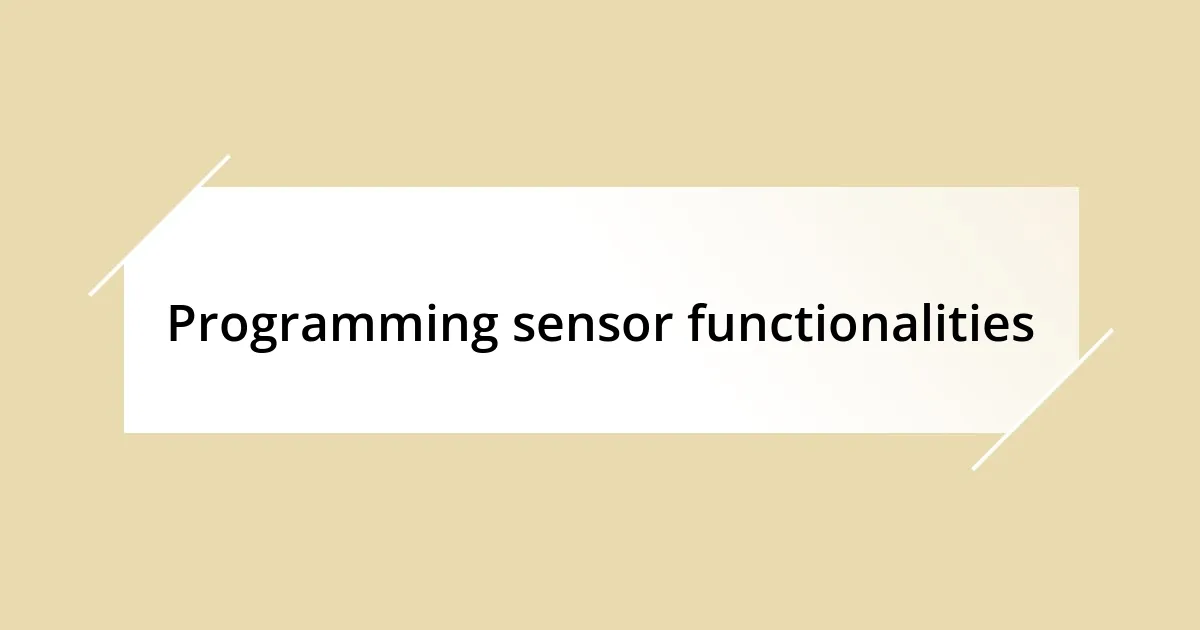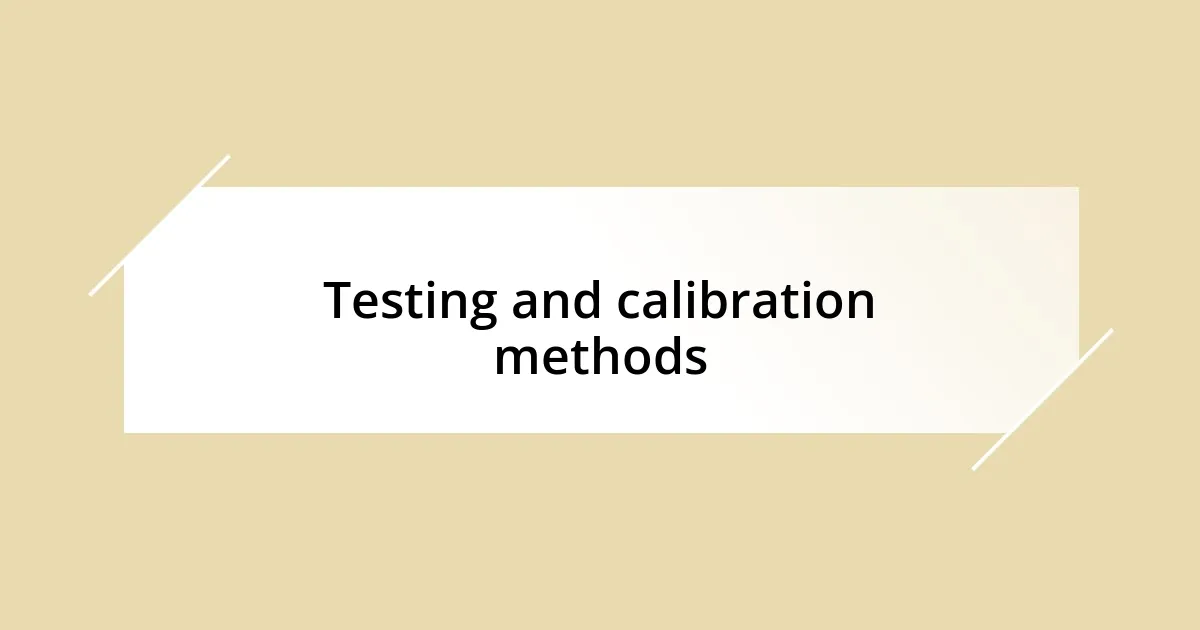Key takeaways:
- Understanding and selecting the right sensors is crucial for successful robot integration, considering factors like purpose, environment, and compatibility.
- Effective wiring and organization significantly enhance troubleshooting and communication between components.
- Thorough testing and calibration of sensors are essential to achieving accurate readings and reliable performance in robotic systems.
- Small adjustments in sensor placement or settings can lead to significant improvements in functionality, highlighting the importance of an iterative approach to modifications.

Understanding sensor types
When I first began integrating sensors into my robot, I found myself immersed in a world filled with various types, each serving unique purposes. For instance, infrared sensors can detect obstacles, giving the robot a sense of its surroundings. I remember the first time I used one — it felt almost magical to see my robot navigate around furniture with such finesse.
Then there are temperature sensors, which allow your robot to monitor its environment. I was fascinated when I programmed mine to react to changes in heat. It was an eye-opening experience to see how my robot could potentially warn me of an overheating component, blending functionality with safety. How cool is it that sensors can enhance not just performance, but also protection?
I’ve also dived into the realm of ultrasonic sensors, often used for distance measurement. They’ve become essential in giving my robot spatial awareness. I can’t help but chuckle when I think about the times I had to fine-tune the settings after noticing it sometimes mistook my pet for an obstacle! It’s these little quirks that make building and working with sensors so endearing and educational.

Choosing the right sensors
Choosing the right sensors can be a bit daunting due to the variety available, but I learned that it’s crucial to align them with your robot’s intended tasks. For instance, while experimenting with different sensors, I quickly realized that the choice between ultrasonic and infrared sensors boils down to what type of environment the robot will navigate. My first robot struggled to detect objects accurately until I swapped its infrared sensor for an ultrasonic one. That change made all the difference — it felt like unleashing the robot’s potential!
Here are some factors I considered when selecting sensors:
- Purpose: What specific task or function do you want the robot to perform?
- Environment: Will it operate indoors, outdoors, or both? Different sensors perform better in varying conditions.
- Range: How far does the sensor need to detect objects?
- Compatibility: Ensure the sensor integrates well with your existing hardware and software setup.
- Cost: Balance performance and budget — sometimes, an affordable option can work just as effectively.
Navigating these choices effectively can transform your project, and trust me, the right sensor can bring your robot to life in ways you didn’t think possible!

Designing the integration system
When designing the integration system for my robot, I realized it was more than just wiring up sensors. It was about creating a cohesive framework that allowed all components to communicate seamlessly. I remember feeling a sense of accomplishment as I mapped out how each sensor would connect with the microcontroller, ensuring the data flow was smooth. This careful planning not only simplified troubleshooting later on but also empowered my robot to respond intelligently to its environment.
Another key aspect was considering power consumption. My initial design didn’t account for the current draw of multiple sensors, and I faced some hiccups when the system became unstable. After experiencing a few frustrating moments, I learned how to manage the power supply effectively, ensuring that every component worked in harmony. This experience taught me that the integration system is a balance of efficiency and functionality.
As I pieced it all together, I appreciated the importance of modularity. Creating a design that allowed easy upgrades and repairs was crucial. In fact, I often say that flexibility in your integration system can save you both time and headaches in the long run. It’s like building a puzzle where each piece has its own place, making it easy to adapt as new technology emerges!
| Aspect | Considerations |
|---|---|
| Communication Protocols | I opted for I2C, as it allowed multiple sensors to connect on the same bus, making integration straightforward. |
| Power Management | Initial issues highlighted the need for careful planning; I learned to calculate total current draw early on. |
| Modularity | I designed the system so that upgrading sensors in the future wouldn’t require a complete redesign. |

Wiring and connectivity solutions
When it came to wiring and connectivity, I found myself immersed in a world where precision truly matters. In my early attempts, I opted for generic jumper wires, which sometimes created loose connections that left my sensors malfunctioning. I vividly remember the frustration of watching my robot erratically navigate obstacles. That experience taught me the value of investing in high-quality connectors and soldering techniques to ensure reliable communication between components.
I also learned the importance of organization. Labeling wires and using color-coded systems transformed a chaotic mess into a tidy workspace, making my life so much easier during troubleshooting. Have you ever been lost in a tangle of wires? I certainly have, and it’s not a fun place to be. Now, every time I prepare for a project, I make sure to spend time ensuring my wiring setup is clean and clear, reducing confusion and saving valuable time down the line.
Lastly, I embraced the use of prototyping boards, which allowed me to test connections without committing to a permanent design. It was a revelation! I could easily rearrange components to see how they interacted before finalizing my setup. This iterative process helped me refine my design and provided an invaluable learning experience. Trust me, once you start experimenting with these practices, you’ll find that effective wiring and connectivity solutions can elevate your robotic projects to new heights.

Programming sensor functionalities
When I first started programming the various sensors, I quickly discovered how critical it was to define their functionalities clearly. Each sensor had unique characteristics, so I took the time to study their datasheets and understand their capabilities. I remember the satisfaction I felt when I successfully coded a simple ultrasonic distance sensor to measure distances accurately. It was as if my robot could see the world in a whole new way, and I was the one giving it those eyes!
Debugging sensor inputs proved to be another fascinating challenge. I often found myself staring at lines of code, wondering why my temperature sensor wasn’t relaying the correct readings. It was stressful, but I transformed that frustration into motivation. By utilizing serial print statements, I was able to check the sensor’s communication in real-time. Through trial and error, the victory of finally getting accurate sensor feedback was so rewarding. Can you relate to that moment when frustration turns into sheer joy? It’s a feeling that fuels your passion for robotics!
Additionally, integrating sensor data into a cohesive system required understanding how to calibrate each sensor for optimal performance. I spent hours tweaking parameters and adjusting thresholds for my light sensors, and I realized how vital these nuances were for accurate readings. It was a balancing act between experimentation and precision, which, truth be told, kept me on my toes. Each adjustment came with lessons learned, and I love sharing this insight: be patient with yourself. Mastering the art of programming sensor functionalities is less about perfection and more about embracing the journey.

Testing and calibration methods
Testing and calibration is where the magic truly happens in robotics. I remember my first calibration session with an accelerometer—at first, I didn’t realize how crucial it was to align the device with its reference frame. After inadvertently having my robot spin out of control, I quickly grasped that proper calibration dictates not just accuracy but also the effectiveness of the entire system. Have you ever noticed how a small misalignment can throw everything off? It’s a humbling experience that teaches you to respect the intricacies of sensor interactions.
One effective method I found invaluable was running a series of systematic tests under controlled conditions. By observing the sensor outputs in a static environment before introducing movement, I could identify discrepancies that would be lost in the chaos of a more dynamic setting. I vividly recall lining up various distance measurements and noted how subtle variations could inform adjustments. It felt almost scientific, leading to moments of clarity when everything suddenly clicked together, contributing to my understanding of how to streamline my calibration process.
Throughout my journey, I also relied heavily on software calibration tools. These applications allowed me to visualize real-time data, enhancing my focus on adjustments. I can still feel my heartbeat quicken as I watched the graphs stabilize after a few tweaks! It’s astonishing how technology can simplify what once seemed overwhelming. Have you experienced that rush of satisfaction when everything aligns perfectly after hours of work? These moments reinforce my belief that thorough testing and calibration are not mere tasks but integral steps in mastering robotics.

Evaluating performance and adjustments
Once my sensors were integrated, evaluating their performance was my next challenge. I remember the adrenaline rush during those initial testing phases. It felt like I was right on the edge of a breakthrough each time I checked the output readings. Was the data consistent? Did it reflect the real-world conditions accurately? I often caught myself holding my breath, waiting to see if everything was functioning as planned. Those moments of anticipation made the eventual results all the more satisfying, reminding me why I fell in love with robotics in the first place.
After gathering data, I realized that making adjustments was an art form in itself. Sometimes, a minuscule change in sensor placement or threshold values could yield surprisingly significant improvements. I recall one instance when I adjusted the sensitivity of a humidity sensor and saw the readings stabilize almost immediately. Isn’t it fascinating how such small tweaks can lead to major enhancements? These experiences taught me to approach modifications with both thoughtfulness and a willingness to experiment. If you feel stuck, don’t hesitate to iterate—sometimes the best insights come from simply trying again.
Monitoring sensor performance wasn’t just about analyzing the outputs, but also about interpreting how they influenced my robot’s actions. I often found myself pondering the interplay between sensors’ feedback and the robot’s movement decisions. Like the time my robot miscalculated a turn due to sensor noise, leading to a rather comical—and somewhat embarrassing—zigzag across the floor. In real-time, I learned to refine the algorithms responsible for decision-making. Can you imagine the learning curves we navigate in these situations? Embracing those unexpected detours ultimately guides us toward better solutions and a deeper understanding of our creations.














